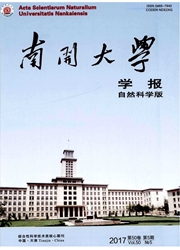

 中文摘要:
中文摘要:
通过双向指示种分析法(TWINSPAN)及除趋势典范对应分析法(DCCA)对植被群落进行分类和排序,并通过GIS图直观表现多样性指数的分布情况.研究发现,经过TWINSPAN分类,并结合考察实际情况,50个样方划分为6个植被类型,分别为乔木群落;灌丛;灌草丛;草甸植被;藤本植物;湿生、水生植被.DCCA二维排序和TWINSPAN分类结果较一致,其中样方排序能够很好地反映群落的生境特征.排序轴的第一轴,从左到右,群落由中生、旱生群落演变成为中生、湿生群落,反映了水分的变化情况.排序轴第二轴从下到上,群落类型从草本植物变为灌丛再变为乔木群落,近似反映了地形上坡度的变化.通过GIS图可以发现,物种丰富度较高的群落主要集中于乔木群落及灌丛;而α指数较高的群落主要集中于乔木(人工林)、农作物、部分野生灌木和草本群落,灌木群落的多样性处于中间水平,藤本植物和水生植物群落的多样性指数都处于较低水平.这与人工干扰强度较大以及超级植物大量繁殖占据生态位有很大关系.
 英文摘要:
英文摘要:
Two-way Indicator Species Analysis(TWINSPAN)and Detrended Canonical Correspondence Analysis(DCCA)were used to know more about the classification and ordination of plant communities,and the figures of GIS were used to give visual representation of the distribution of species diversity.The results showed that six typical vegetation types,Arboreal communities,Thickets communities,Irrigation grass communities,Meadow vegetation communities,Lianas communities,Wet and aquatic vegetation communities,were determined after combining the WINSPAN classification results and actual investigation results.The results of DCCA ordination verified the results of TWINSPAN,the ordination of samples could better reflect the habitat characteristics of plants communities.From the left to right of axis 1,the dominated species changed from xerophytic communities to aquatic or wet communities,which reflected the change of water condition.From the bottom to up of axis2,the community type changed from herbaceous plants communities,shrub communities,arboreal communities,which approximately reflected the change of slope.The species diversity results were better vertified by using GIS figures,communities with high species richness mostly focused on arboreal communities and thickets communities,while communities with highαdiversity mostly focused on arboreal communities(plantations),crops,wild thickets communities and herbaceous communities.Theαdiversity of thickets communities stayed at an intermediate level.Lianas communities and aquatic vegetation communities showed the lowestαdiversity.This was related to the intensity of high artifical interference and the large propagation of super plants.
 同期刊论文项目
同期刊论文项目
 同项目期刊论文
同项目期刊论文
 期刊信息
期刊信息
